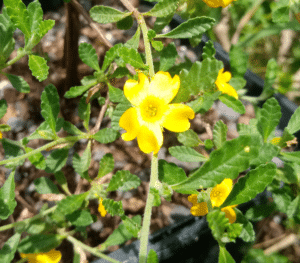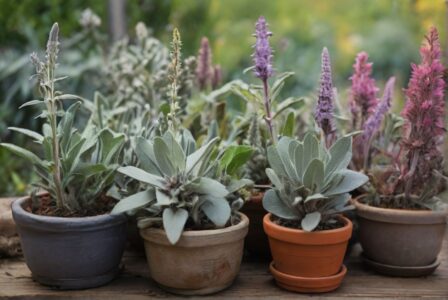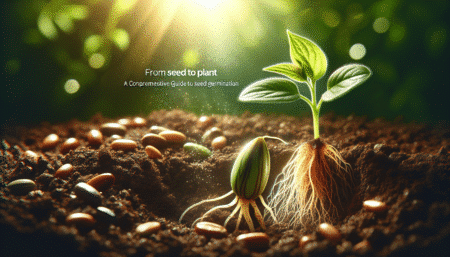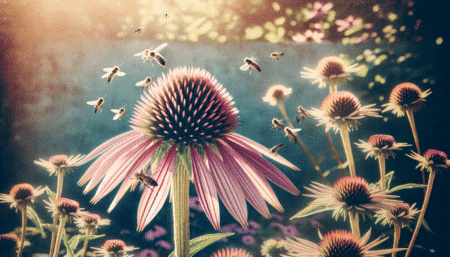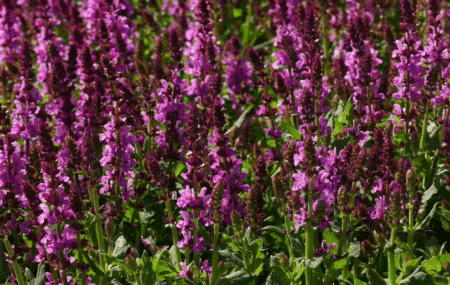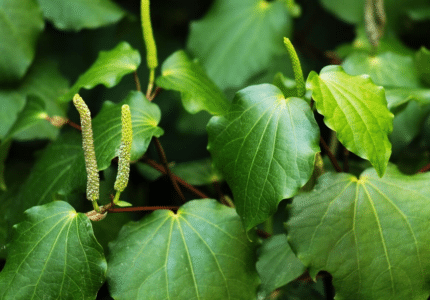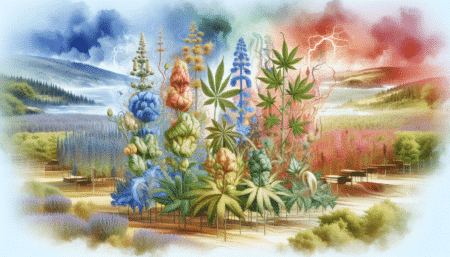- Why grow and use damiana?
- Site selection for Damiana cultivation
- Soil conditions and preparation for the growth of damiana
- Growing and propagating damiana
- Care and watering of the damiana plant
- Harvest time and harvesting methods for damiana leaves/flowers
- Drying, storage and preservation of dried damiana material
- Possible uses of damiana as a tea, tincture or smoking agent
- Health benefits of damiana for physical vitality
- Conclusion: enjoyable relaxation with home-grown damiana
Are you interested in growing and using damiana? This article will tell you everything you need to know. Damiana, also known as Turnera diffusa, is a plant from Mexico whose leaves and flowers can be used in a variety of ways. From its effects to recipes and products - here you will find all the answers and articles to include damiana in your herbal category. Immerse yourself in the world of medicinal herbs and discover the wonderful damiana plant.
1 Why grow and use damiana?
Why grow and use damiana? We answer this question in this article. Damiana (Turnera diffusa) is a plant from the category of medicinal herbs that originally comes from Mexico. The leaves and flowers of damiana are valued for their diverse effects and are used in various products. The cultivation of damiana offers numerous advantages. For one, growing and harvesting your own herbs is a rewarding experience. In addition, you can be sure that the plants used are free from pesticides or other harmful substances. The effects of damiana are well researched and documented.
It is believed that the plant's ingredients have a calming effect and can therefore contribute to relaxation. Damiana is therefore often used as a tea or tincture to relieve stressful situations and provide inner peace. But that's not all: damiana is also used as a smoking agent. It is said that inhaling the smoke can have a relaxing effect and at the same time exude a pleasant aroma. Overall, the cultivation and use of damiana offers many opportunities for personal relaxation and enjoyment. In the next sections, we will look at the details of cultivation - from the choice of location to harvest time - as well as tips on care. Stay tuned for more exciting information and find out how you can experience pleasurable relaxation with damiana.
2. choice of location for Damiana cultivation
When it comes to growing damiana, the choice of location plays a decisive role. Damiana, botanically known as Turnera diffusa, is a plant from the passionflower family and originally comes from Mexico. For successful growth and a good harvest of Damiana leaves and flowers, it is important to choose a suitable location. Ideally, the location should be sunny to partially shaded, as damiana needs a lot of light. The plant prefers warm temperatures and does not tolerate severe frosts. A sheltered area in the garden or on the balcony is therefore ideal for growing Damiana. It is also advisable to prepare the soil before planting. The soil should be well-drained and have sufficient nutrients.
A mixture of compost or well-rotted manure can provide the soil with additional nutrients and promote the growth of the damiana plants. Another aspect to consider when choosing a location is the availability of water. As damiana needs to be watered regularly, the chosen location should be close to a water source or easily accessible. Overall, choosing the right location for growing damiana is crucial to the success of the project. By looking for sunny to semi-shaded areas, preparing the soil and ensuring a good water supply, you can create the conditions for Damiana to grow healthily. With the right conditions, you will soon be able to harvest fresh damiana leaves and flowers and use them for various purposes such as teas or recipes. So let's get started! Choose the perfect location and enjoy the many benefits of this wonderful medicinal plant.
3. soil conditions and preparation for the growth of damiana
An important consideration when growing damiana is the condition and preparation of the soil. Damiana, also known as Turnera diffusa, originates from Mexico and thrives best in well-drained soil. To create optimal growing conditions, the soil should be loose and have good water drainage. A good way to achieve this is to add organic material such as compost or rotted manure to loosen the soil and increase its fertility. It is important to ensure that the soil contains sufficient nutrients to support the healthy growth of Damiana plants. A soil test analysis can be helpful here to determine whether certain nutrients are lacking or present in excess.
Depending on the results of the test, targeted fertilizers can be used. Another aspect of preparing the soil for the growth of Damiana is pH adjustment. The plant prefers a slightly acidic to neutral pH between 6 and 7. If the pH of the soil is not optimal, it can be adjusted with the addition of lime or sulphur. To ensure that the Damiana plants can develop successfully, weeds should be removed before planting. This reduces competition for water and nutrients and promotes healthy growth of the Damiana plants. Soil composition and preparation are crucial factors for growing damiana. Providing the soil with the right structure, nutrients and pH levels lays the foundation for healthy plant development. With a carefully prepared soil, it will be possible to harvest high-quality damiana leaves and flowers and use them for various purposes such as tea or tinctures.
4. growing and propagating damiana
Damiana is a versatile plant that is not only known for its beneficial effects, but is also relatively easy to grow and propagate. In this section, we will take a closer look at how to successfully grow and propagate damiana. To grow damiana, you first need high-quality seeds or seedlings. These can be purchased in garden centers or online stores. It is advisable to select high-quality seeds in order to achieve optimum results. Damiana thrives best in sunny to semi-shady locations with well-drained soil. A single frost can damage the plant, so it should be protected from cold temperatures. Damiana can be propagated either by seeds or cuttings. Seeds should be sown in spring and usually germinate within 2-3 weeks at a temperature between 20-25°C.
The germination rate can be improved by soaking the seeds in lukewarm water for 24 hours before sowing. Cuttings can be cut in summer and rooted in moist sand or vermiculite. After a few weeks, new roots will form and the cuttings can then be transplanted into pots with good soil. It is important that Damiana is watered regularly, especially during dry periods. However, waterlogging should be avoided as this can damage the roots. A layer of mulch around the plant can help retain moisture and reduce weed growth. By growing and propagating damiana, you have the option of having fresh leaves and flowers available for your own use at all times. This also allows you to try out different recipes and enjoy the versatile effects of damiana to the full.
5. care and watering of the damiana plant
Damiana is a versatile plant that is not only easy to grow, but also requires good care and watering to develop its full potential. To ensure that your damiana plants grow healthy and strong, there are a few important things to consider. First of all, you should regularly check the soil moisture level. Damiana prefers evenly moist soil, but avoid waterlogging. A good rule of thumb is to allow the soil to dry about 2-3 centimeters deep between waterings. The best time to water Damiana plants is in the early morning or late evening. This ensures that the water is absorbed effectively and does not evaporate as quickly. Be careful not to wet the leaves and flowers directly when watering, as this can encourage fungal infections.
Another important aspect of damiana care is the regular removal of weeds from around the plants. This prevents competition for nutrients and water as well as possible pests. For optimal development, it is also advisable to apply organic fertilizer every few weeks. This provides the plants with important nutrients for healthy growth. Finally, Damiana is generally a hardy plant with little susceptibility to diseases or pests. With the right care and watering, you will certainly be rewarded with a lush and vital Damiana plant, ready to unleash its healing properties in the form of leaves and flowers. Remember: caring for your damiana plants is crucial to their success. Therefore, take the time to give them the attention they deserve. In combination with the information in this article, you will certainly be able to achieve a good harvest of damiana leaves and flowers.
6. harvest time and harvesting methods of Damiana leaves/flowers
The time and methods of harvesting damiana leaves and flowers play a crucial role in ensuring the optimum quality of the plant. Damiana, also known as Turnera diffusa, is a popular medicinal plant from Mexico and is highly valued in the category of medicinal herbs due to its diverse effects. To determine the right time for harvesting, you should first focus on the flower constellation. The flowers should be fully open and exude an intense fragrance. This indicates that they have reached their peak and are ripe. The leaves, on the other hand, can be harvested before flowering as soon as they are bright green and have reached their full size. There are various approaches to harvesting methods. You can either selectively cut individual leaves or entire branches. Both methods have advantages and disadvantages:
Selective cutting makes it possible to harvest only mature leaves without putting too much strain on the plant. Cutting whole branches, on the other hand, gives you more material at once, but then you also have to sort out unripe or damaged leaves. After the damiana material has been harvested, it should be gently cleaned to remove any impurities. It can then be spread out or hung up to dry. Good ventilation is important here to prevent mold growth. Once the leaves and flowers are completely dry, they can be stored in airtight containers to preserve their freshness and potency. The timing and harvesting methods of damiana leaves and flowers are crucial for the quality of the plant and also influence the taste of the subsequent tea or other damiana products. By paying attention to the correct ripeness of the flowers and choosing a gentle harvesting method, you can ensure that you get the best out of this wonderful medicinal plant.
7. drying, storage and preservation of dried damiana material
After you have carefully grown and harvested your damiana plants, it is important to dry, store and preserve the dried damiana material properly. This ensures that the valuable ingredients of the damiana leaves and flowers are preserved and can develop their full effect. To dry the damiana material, you can spread out the leaves and flowers in a well-ventilated place or hang them up carefully. Make sure that they are not exposed to direct sunlight, as this can affect the sensitive ingredients. It can take several days to weeks for the material to dry completely. Once the damiana material is dry, you should store it in airtight containers such as glass jars or sealable bags. This protects against moisture and keeps the material fresh. Keep the container in a cool and dark place to ensure optimal shelf life. The dried damiana material can be used in a variety of ways - be it as a tea infusion for relaxing moments or as an ingredient for various recipes such as liqueurs or pastries.
The healing properties of damiana have been appreciated for centuries and originated in Mexico. In our range you will find high-quality products from the "Herbs" category and especially from the damiana plant. Our damiana leaves and flowers have been carefully selected and gently dried to preserve their effects as well as possible. You can rely on our quality. You can find answers to frequently asked questions and article numbers for further information in our extensive selection of Damiana products. Take a look and discover the many possible uses of damiana. We welcome reviews and feedback on our products. Feel free to share your experiences with us and let us know how you liked the Damiana material. Together we can get the best out of this wonderful plant!
8. possible uses of damiana as a tea, tincture or smoking agent
Damiana, also known as Turnera diffusa, is a versatile plant with a range of uses. In addition to cultivation and propagation, there are various ways in which you can use damiana. One popular option is the preparation of damiana tea. The dried leaves and flowers are used for this. The tea has a pleasant taste and is often valued for its relaxing effect. You can either drink it on its own or mix it with other herbs to create your own tea blends. Another option is to make a damiana tincture. This involves soaking the leaves and flowers in alcohol to extract their valuable ingredients. The tincture can be used internally, for example by stirring it into water or dripping it directly under the tongue. It is considered a tonic for the nervous system and can help with stress and anxiety.
Damiana is also used as a smoking agent. The dried leaves are smoked, either on their own or in combination with other herbs. This use has a long tradition in Mexico, where damiana is originally from. The uses of damiana are diverse and offer you many options for relaxing and boosting your physical vitality. Whether as a tea, tincture or smoke, damiana can be a valuable addition to your herbal category. Try out different recipes and products to find the right effect for you. Damiana is a medicinal herb with a good rating and has a firm place in the herbal category. So what are you waiting for? Discover the many uses of damiana and enjoy relaxing moments just the way you like them!
9 Health benefits of damiana for physical vitality
Damiana, also known as Turnera diffusa, is a versatile plant and belongs to the category of medicinal herbs. In addition to its delicious taste and pleasant aroma, damiana offers several health benefits for physical vitality. In this article, we would like to focus on this specific topic and show you why damiana can be a good choice for your health. The leaves and flowers of damiana contain various active ingredients that can have a positive effect on the body. For one, damiana is often referred to as a natural aphrodisiac, as it can increase libido. It can also help to increase general energy levels and improve stamina. For people suffering from tiredness or fatigue, regular consumption of damiana leaves or tea can be a natural way to support their physical vitality. In addition, damiana also has calming properties and can help with stress or anxiety.
Thanks to its relaxing effect, it can help you feel more balanced and better able to cope with stress. This in turn has a positive effect on your general health and well-being. In Mexico, damiana is traditionally used to support the digestive system. It has been found to have a soothing effect on stomach complaints such as indigestion or cramps. A damiana tea after a meal can therefore be a beneficial and health-promoting option. In conclusion, damiana offers many health benefits for physical vitality. It is a versatile plant that can be enjoyed in various forms such as tea or tincture. If you would like to grow and use your own damiana plant, you should also read the other articles in this blog for all the important information on choosing a location, cultivation and use. Discover the natural effects of this fascinating plant and enjoy the positive effects on your health!
10. conclusion: enjoyable relaxation with home-grown damiana
Now that you have received all the important information on the cultivation and use of damiana, we would like to finish with a conclusion. Home-grown damiana not only offers the opportunity to have a valuable medicinal plant in your own four walls, but also provides enjoyable moments of relaxation. The leaves and flowers of damiana unfold their healing effects both as a tea and in the form of tinctures or smoking products. You can rely on high quality, as home-grown damiana guarantees fresh and unadulterated products. It is also a fulfilling feeling when you can grow your own plant category and thus become part of the herbal cycle. Whether you want to unwind after a stressful day or simply enjoy the relaxing effects of damiana, this medicinal plant from Mexico offers you many possibilities. With the right recipes and preparation methods, you can make the most of your own damiana leaves and benefit from their positive effects on body and mind. So don't hesitate any longer and embark on the adventure of growing damiana - it's worth it!
Further questions and answers about damiana
What does damiana do?
Damiana, also known as Turnera diffusa, is a plant native to Central America. It has been used for centuries for its medicinal properties. But what exactly does damiana do? One of the main effects of damiana is its aphrodisiac effect. Damiana is believed to increase blood flow and sensitivity in the genital area, thereby increasing sexual desire and performance. In addition, damiana is often used as a natural tonic for the nervous system. It can have a calming effect and reduce stress. This can help to alleviate anxiety and improve general well-being. Damiana is also used to aid digestion. It can help with digestive problems such as stomach cramps, bloating or constipation. Another possible benefit of damiana is its anti-inflammatory effect. It can be used for inflammatory conditions such as arthritis or rheumatism. There are also some claims about the positive effects of damiana on hormonal balance in women. It is said to relieve menstrual cramps and improve overall well-being during the menstrual cycle. However, it is important to note that scientific research into the exact effects of damiana is limited and further studies are needed to confirm these claims. You should always consult a doctor before taking damiana, especially if you are already taking medication or have health problems.
How long does it take for Damiana to take effect?
It usually takes around 30 to 60 minutes for damiana to take effect. However, the exact duration can vary from person to person. Some people report feeling a noticeable effect after just 15 minutes, while for others it may take longer. Damiana is a plant that is often used to increase libido and as a natural aphrodisiac. The effects of damiana are thought to occur in several ways. Firstly, the plant contains certain compounds that can have a stimulating effect on the nervous system. This can lead to increased sexual arousal. In addition, it is believed that damiana can also improve blood circulation in the body. Better blood flow can help increase blood flow to the genital area, leading to increased sexual arousal. It is important to note that damiana may not be effective for everyone immediately. Some people may need several doses or regular use over a longer period of time to feel positive effects. It is recommended to follow the dosage instructions on the product label and consult a doctor or pharmacist if necessary.
How healthy is damiana?
Damiana is a plant that is native to Central and South America. It is often used as a medicinal plant and has a long history in traditional medicine. In terms of its health benefits, there are several potential positive properties. One of the most well-known properties of damiana is its aphrodisiac effect. It is believed to be able to increase libido and act as a natural sexual enhancer. In addition, damiana is often used to treat menstrual cramps as it has antispasmodic properties. Another possible health benefit of damiana is its relaxing effect on the nervous system. This can help relieve stress, anxiety and insomnia. Some studies also suggest that damiana may have anti-inflammatory properties. However, it is important to note that further research is needed to confirm the exact health effects of damiana. Studies to date are limited and there is insufficient scientific evidence of its effectiveness. As with all herbal remedies, precautions should be taken when taking damiana. Side effects can occur, especially when taken in large quantities or over a long period of time. Overall, it can be said that damiana may have potential health benefits, particularly in terms of increasing libido and relieving stress. However, it is important to await further research to get a solid assessment of its effectiveness.
How much damiana per day?
The recommended daily dose of damiana varies depending on the intended use and individual needs. As a rule, it is recommended to take 400-800 mg of damiana three to four times a day. However, this dosage may vary depending on the product and concentration. It is important to follow the instructions on the product label or the recommendations of a qualified healthcare provider. There are several ways to take damiana. It can be prepared as a tea by pouring hot water over 1-2 teaspoons of dried damiana leaves and leaving to infuse for 10-15 minutes. Damiana capsules or tablets can also be taken, although the dosage should be adjusted accordingly. It is advisable to start with a lower dose and observe the effect before taking a higher dose. Everyone reacts differently to herbal preparations such as damiana, so it is important to pay attention to the body's individual reaction. If you have any further questions about taking damiana or are unsure, you should consult a doctor or other healthcare professional. They will be able to give you precise dosage instructions according to your specific situation. Please note that this information is not intended as a substitute for professional medical advice and you should always seek the advice of your doctor before taking any new supplements.
Related links to Damiana
- https://de.wikipedia.org/wiki/Damiana
- https://kraeuterkontor.de/magazin/damiana/
- https://www.zavamed.com/de/damiana.html
YouTube
Note: The information in this article is for informational purposes only and is not intended to replace the advice of a physician or other healthcare professional. Always consult a doctor before using any new herbs or supplements. Furthermore, you should always check whether the cultivation/possession/use/processing of certain plants is permitted in your country. As we only offer ornamental plants in our store, we are allowed to only Provide information and advice on the correct care of plants!

